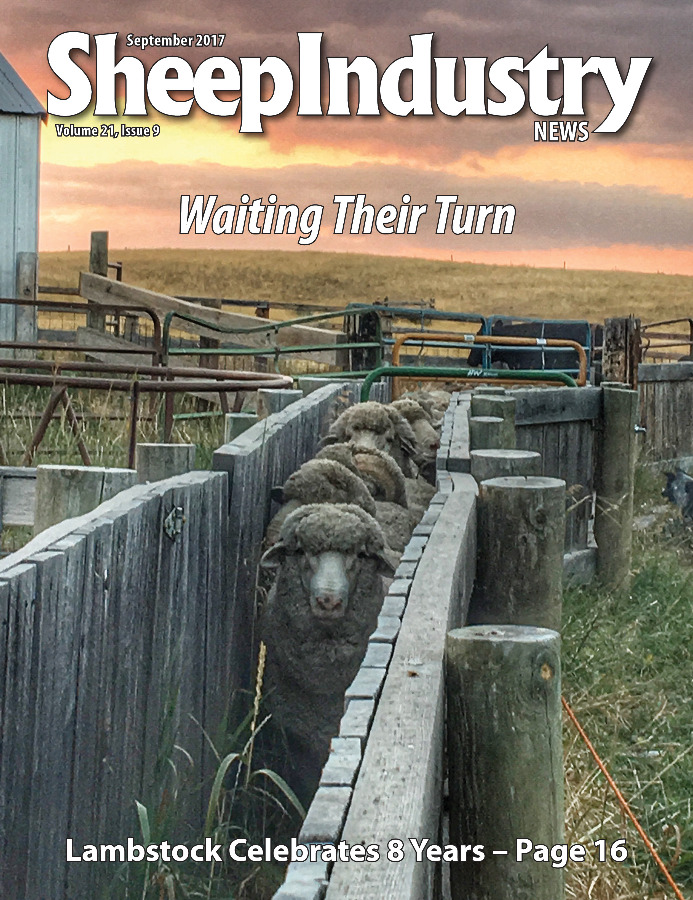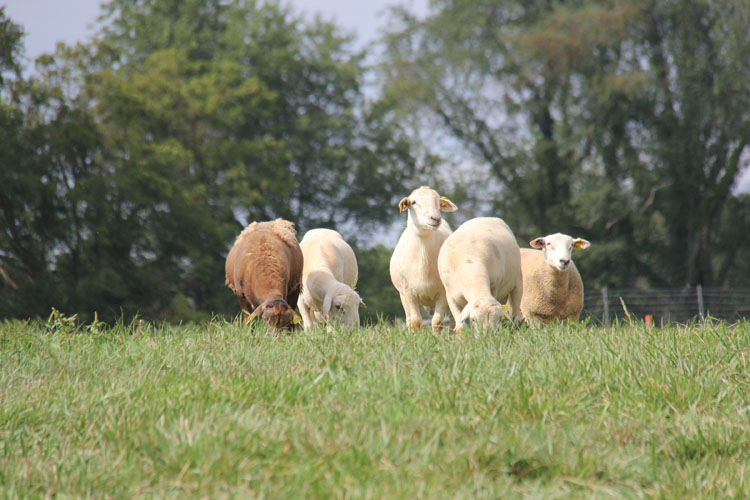
- September 2017
- President’s Notes
- AmericanWool.org Launches
- Priority 1: Parasite Resistance
- Lambstock 2017
- Kopanke Earns Scholarship
- Clements Perseveres in South Dakota
- Court Upholds Wyoming Grazing
- Industry Impact Study Available
- Committee Discusses H-2A
- Executive Board Meets in Park City
- Market Report
- The Last Word
Priority 1: Parasite Resistance
Virginia Tech Ram Test & Sale Has Different Focus
Any number of states offer the opportunity for producers to take part in ram tests, but the Virginia Tech Southwest Ag Research and Extension Center Ram Test is different in that it places an emphasis on parasite resistance.
“I could go home and do fecal egg counts with my flock – anyone can,” said Virginia Tech Sheep Extension Specialist Scott Greiner, Ph.D. “The unique thing about our ram test is that we’ve challenged all of these rams by artificially infecting them with a standard dose (an oral dose of 3rd stage H. contortus larvae appropriate for their body weight). We know they have parasites. We’re measuring their response to that. This evens the playing field, and the environment is the same for each ram. So we get a good measurement to how these rams are responding.”
 Rams arrived at the research center on June 1. At delivery, rams were weighed, vaccinated for clostridial diseases and soremouth, had their feet trimmed and soaked, and scrotal measurements were taken. Additionally, at delivery, rams were dewormed with three anthelmentics (moxidectin, levamisole, and fenbendazole), and fecal samples were collected to determine presence of nematode parasites.
Rams arrived at the research center on June 1. At delivery, rams were weighed, vaccinated for clostridial diseases and soremouth, had their feet trimmed and soaked, and scrotal measurements were taken. Additionally, at delivery, rams were dewormed with three anthelmentics (moxidectin, levamisole, and fenbendazole), and fecal samples were collected to determine presence of nematode parasites.
A three-week drylot adjustment period was used to acclimate the rams to pastures and supplemental concentrate diet, as well as to assure fecal egg count reduction. A subsequent FEC was taken 12 days following delivery.
“We recheck fecal egg counts because we want them all down as close to zero as we can get before the test begins,” said Southwest AREC Superintendent Lee Wright.
After the adjustment period, rams are given their standard dose of larvae, turned out on the research station’s fescue pastures and receive 3 percent of their body weight in the supplemental daily ration. Six performance measures are in place for the test:
• Test Average Daily Gain (ADG) = total weight gain/number of days on test;
• Weight Per Day of Age (WDA) = weight/age in days;
• ADG Ratio = individual ADG/test group average ADG;
• WDA Ratio = individual WDA/test group average WDA;
• FEC – reported at 14 day intervals;
• FAMACHA scores – reported at 14 day intervals.
The top 30 to 40 rams (of 110 that took part in the test) will be available in a sale on Sept. 22 at the research station in Glade Spring, Va. Identifying rams with the genetic potential for growth and parasite resistance for individual consignors is the main objective. Having quality, tested rams for the sale is an added benefit for producers seeking these genetics.
“Consignors can look at the data and pick and choose which of their eligible rams go to the sale,” Wright said. “We’ve limited it so that consignors can only include half of their test animals at most in the sale. There will be some who will have a ram that does really well during the test, and they’ll decide to take that ram home and put him into their breeding program. We have consignors who have been selecting for parasite resistance for years within their own flocks at home, and it shows when they come here with their rams. Those animals tend to do well here. It’s something for others to strive for. When they see how well one animal (or a group of animals from one flock) does, it gives them a goal to work for. This isn’t really a competition, but I think all producers want to see their animals do well.
“A majority of the consignors are National Sheep Improvement Program breeders and they have estimated breeding values on their flock. They are just as interested in the data as they are in selling a ram. They want to see how they perform on this test.”
Katahdins – a breed known for its parasite resistance – make up much of the test field thanks to their popularity in areas where parasites present a regular problem for sheep producers. But not all Katahdins are created equal.
“If you just came in here and randomly grabbed a Katahdin ram, then yes he would be more parasite resistant than a lot of other sheep from different breeds,” said Greiner. “If you picked the right Katahdin, he might beat any ram from any other breed. If you picked the wrong Katahdin, he might not be any different than a Dorset or a Suffolk. The key to parasite resistance is that you have to measure it and document it – just like any other trait in sheep.”
With the growing interest in hair sheep in the Southeastern part of the United States, Virginia Tech began to ramp up research on the breeds in the late 1990s. Interest swelled around 2004 and 2005 as many small Virginia farms abandoned tobacco, which was a small acreage crop that worked perfectly in the mountains and foothills that dominate the state’s western landscape. Other crops weren’t suited to the land, so sheep took tobacco’s place.
“Our first objective was to study the hair breeds and document the strengths and weaknesses compared to other breeds. They were pretty new at that point. There wasn’t much data to say what they’re good at and what they aren’t,” Greiner said. “Explosion and interest in particularly Katahdins is based on parasite resistance, as well as their success in forage-based systems. We don’t need a 150-pound market lamb here, not a market for that. So the smaller Katahdins are a good fit for the ethnic market where a lot of our lambs end up.”
The ram test allows producers from Virginia (as well as surrounding states and those as far away as Missouri and Wisconsin) to identify not only their top-end rams, but also those who aren’t as prolific in the area of parasite resistance.
“By weeding out the ones on the bottom, a producer can improve his flock in just a few years in the area of parasite resistance,” Greiner said. “For that trait, playing the averages isn’t good enough anymore. We have to be able to select for it. I don’t think there any new dewormers or magic coming down the pipe anytime soon. They’re a tool, just like selecting for resistance is a tool, FAMACHA is a tool. We have to mix them together to make it all work.”
Visit apsc.vt.edu/extension/sheep/swarec-ram-program/ to learn more about the ram test and sale.

